The Least Developed Countries Report 2020: Productive Capacities for the New DecadeThe coronavirus disease (COVID-19) pandemic is taking its toll on economies of least developed countries (LDCs). To help economies and aid their recovery from the pandemic, this report lays out proposed measures for improving productive capacities of LDCs. It looks at mechanisms for regional cooperation in the areas of green technologies, industry, and digital technologies. The report takes a look at regional integration schemes, such as the South Asian Free Trade Area, and discusses how these could be instrumental in the sustainable and inclusive recovery for LDCs. Author: United Nations Conference on Trade and Development Year: 2020 Download Tags: South Asia, UNCTAD, Least Developed Countries, Regional Cooperation, SAFTA World Tariff Profiles 2018World Tariff Profiles 2018 presents comprehensive data on tariffs and non-tariff measures imposed by over 170 countries and customs territories. It provides data on tariffs imposed by these economies, in comparative tables and one-page profiles. This year's report presents a special analysis of least-developed countries’ (LDCs) use of preferential market access offered by trading partners. It highlights how LDCs benefit from preferential customs duties, and examines products eligible for preferential treatment, to show how members utilize preferential tariff schemes for LDCs and use other "competing" preferential duty arrangements. Author: World Trade Organization Year: 2018 Download Tags: LDC, Least Developed Countries, Customs, Trade Least Developed Countries Report 2017This report focuses on transformational energy access for the LDCs, where 62% of people have no access to electricity. It makes a case for trade in electricity, such as the 2014 South Asian Association for Regional Cooperation framework agreement for regional cooperation on electricity among Afghanistan, Bangladesh, Bhutan, India, Maldives, Nepal, Pakistan, and Sri Lanka. International and regional trade in electricity could help lower electricity prices, mitigate power shocks, relieve shortages, and facilitate the transition to cleaner energy. Author: United Nations Conference on Trade and Development Year: 2017 Download Tags: Bangladesh, Bhutan, Maldives, Nepal, Sri Lanka, Energy, Least Developed Countries, Trade 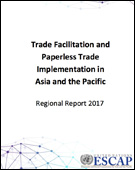 Trade Facilitation and Paperless Trade Implementation in Asia and the Pacific - Regional Report 2017Paperless trade reduces trade costs and enables trade to drive growth and sustainable development. This report shares results of the global survey on trade facilitation and paperless trade implementation, covering 44 countries in Asia and the Pacific. It covers 47 trade facilitation measures, including those involving general trade, paperless trade, cross-border paperless trade, transit, and trade for small and medium-sized enterprises. The report gives an overview of trade facilitation implementation in South and Southwest Asia, and includes Bangladesh, India, and Myanmar in its analysis of transit measures in Asia and the Pacific. Author: United Nations Economic and Social Commission for Asia and the Pacific Year: 2017 Download Tags: UNESCAP, Bangladesh, India, Least Developed Countries, Maldives, Myanmar, Small and Medium Enterprise, Trade Facilitation Agreement, Transport Facilitation, WTO The Asian Economic Integration Cooperation Agreement: Lessons for Economic and Social DevelopmentThis paper focuses on the impact of regional integration on development and poverty reduction in the Association of Southeast Asian Nations (ASEAN) economic community. It examines economic growth, rapid trade, and investment expansion and looks at challenges presented by the deterioration in trade balances in Cambodia, Laos, Myanmar, and Vietnam. It also explores the role of regional integration in addressing the development gap in ASEAN countries. Author: Amelia U. Santos-Paulino Year: 2017 Download Tags: ASEAN, Free Trade Agreements, Least Developed Countries, Myanmar, Regional Cooperation, Regional Integration, WTO World Trade Statistical Review 2017The World Trade Statistical Review looks at the last 10 years and examines the latest developments in world trade, with a detailed analysis of the most recent trends for trade in goods and services. The book gives information on the participation of India, Bangladesh, and other South Asian economies in world trade, and highlights trends in the use of trade-facilitating measures. It also gives information on the implementation of the WTO Trade Facilitation Agreement and regional trade agreements, such as the South Asian Free Trade Arrangement. Author: World Trade Organization Year: 2017 Download Tags: Export, Least Developed Countries, Aid for Trade, SAFTA, South Asia, Trade Facilitation, WTO, Bangladesh, Bhutan, India, Maldives, Myanmar, Nepal, Sri Lanka Implications of Brexit to the Asia-Pacific Region: with a Focus on Least Developed Countries (Trade Insights: Issue No. 20)This issue of Trade Insights, published by United Nations Economic and Social Commission for Asia and the Pacific, discusses how possible Brexit scenarios could adversely affect least developed countries in the Asia-Pacific region. Simulation results show that potential reduction in exports to the United Kingdom for fish, clothes, textiles, footwear, and other key items can range from 16% to 50% of their current export value. According to the study, countries heavily exposed to Brexit-induced risks must analyze the extent of such impact and engage the United Kingdom in discussions in order to limit negative impact. Author: Louis Graham, Arun Jacob, and Anders K. Møller Year: 2017 Download Tags: Asia-Pacific, Least Developed Countries, South Asia, Trade, UNESCAP, India, Bangladesh, Maldives, Myanmar, Nepal, Sri Lanka Facilitate Trade for Development: Aid for Trade The Aid for Trade program has been providing support to developing economies in tackling obstacles to growth through better facilitation of trade in the last 10 years. Since its launch in 2006, a total of $308 billion has been disbursed to finance aid-for-trade programs and projects, which are working to reduce trade and transport costs, promote trade expansion, and achieve economic and social objectives. As high trade costs persist in keeping developing countries from fully exploiting their trade and development potential, the Aid for Trade program remains highly relevant, and will help developing economies, including landlocked and small and vulnerable economies, achieve the 2030 Agenda for Sustainable Development. Author: William Hynes and Frans Lammersen Year: 2017 Download Tags: Trade, Development, Aid for Trade, Trade Facilitation, Transport, Bangladesh, Bhutan, Myanmar, Nepal, Least Developed Countries Trade Facilitation and Global Value Chains: Opportunities for Sustainable DevelopmentThis paper analyzes the relationship between global value chains (GVCs) and trade facilitation, and its contribution to sustainable development outcomes on low-income and least developed countries (LICs and LDCs). A key insight of the paper concludes that it is not fundamentally GVCs that drive the sustainable development implications of improved trade facilitation, but the resulting extension and intensification of economic activity. It underlines the importance of putting in place domestic regulatory infrastructure that considers the appropriate economic, social, and environmental dimensions to ensure that GVCs remain consistent with the global commitment to sustainable development, while expanding economic opportunities of LICs and LDCs. Author: Ben Shepherd Year: 2016 Download Tags: Trade Facilitation, Trade, Global Value Chains, Sustainability, Sustainable Development, Least Developed Countries, LDC Implementing the Trade Facilitation Agreement: From Vision to RealityLow income to upper-middle income countries stand to gain a 14.6% to 16.5% reduction in trade costs upon implementation of the World Trade Organization's (WTO) Trade Facilitation Agreement (TFA). This publication looks at progression of the TFA – from conclusion of the talks at the 2013 Bali Ministerial Conference to preparations for the Agreement to take effect, as the valedictory moment of the TFA's entry into force nears. It highlights milestones, discusses the state of the ratification process, reviews implementation schedules, and examines work still to be done. Author: Nora Neufeld Year: 2016 Download Tags: Trade Facilitation, WTO, Least Developed Countries, Import, Export 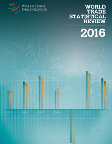 World Trade Statistical Review 2016The World Trade Statistical Review is the World Trade Organization's latest flagship publication offering a detailed analysis of the latest developments on global trade in goods and services—including developments in trade policy and participation of developing economies and least developed countries—examined through analytical chapters, complemented by over 50 tables. The publication reports that in 2015, developing Asia represented 67% of developing economies’ exports. In merchandise trade, India ranked 9th among the world's top exporter of agricultural products, and continues to be one of the top 3 textile exporters, which accounts for nearly 2/3s of world exports. A 25% decline in LDC exports was reported, due to the negative impact of the drop in fuel prices and mining products. LDC participation in global exports of commercial services also remained negligible at 0.8%. In trade policy making, the publication reported that WTO members introduced 132 measures to facilitate trade, yet applied 154 new trade-restrictive measures during the period between mid-October 2015 and mid-May 2016. Author: World Trade Organization Year: 2016 Download Tags: Trade, Export, India, Least Developed Countries 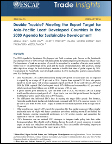 Double Trouble? Meeting the Export Target for Asia-Pacific Least Developed Countries in the 2030 Agenda for Sustainable Development (Trade Insights: Issue No. 15)This paper evaluates the prospects of least developed countries (LDCs) in Asia-Pacific in meeting the target set for LDCs to double their share of global exports by 2020, in Goal 17 of the Sustainable Development Goals (SDG). The paper notes that most Asia-Pacific LDCs have reported strong GDP growth turnout in recent years and are expected to grow by an average of 5.8% in 2016; difficulties faced by individual LDCs vary – Nepal, as an example, would need expansion at the average rate of 19% per year; LDCs can use national SDG strategies and go for longer-term goals—beyond the goals of export expansion—such as aiming to reach targets on trade cost reductions and trade facilitation. Author: Adam Heal, Miso Kim, Juliette Perche, Rajan Sudesh Ratna, and Pakkaporn Visetsilpanon Year: 2016 Download Tags: Least Developed Countries, Exports, Trade Facilitation, Trade, UNESCAP 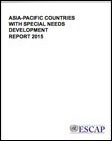 Asia-Pacific Countries with Special Needs Development Report 2015In the Asia-Pacific region, 36 out of the 58 economies are considered countries with special needs (CSN), which include least developed countries (LDC), landlocked developing countries, and small island developing States. This report highlights important areas that should be addressed as key priorities by CSNs such as economic diversification, external trade, South-South cooperation, and official development assistance including foreign direct investment. Bhutan and Nepal met the criteria for graduation from LDC status as of 2013. Other countries such as Bangladesh have a good chance of meeting the graduation criteria by 2018. Among the Small island developing States, Maldives is considered a success story in broadband internet connectivity. The results of this research show that Asia-Pacific CSNs must choose their paths to diversification carefully, depending on country circumstances. Author: United Nations Economic and Social Commission for Asia and the Pacific Year: 2015 Download Tags: Asia-Pacific, Least Developed Countries, Small Island Developing States, Bangladesh, Bhutan, Energy, FDI, Investment, Maldives, Nepal, Trade, Transport, UNESCAP 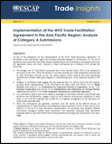 Implementation of the WTO Trade Facilitation Agreement in the Asia-Pacific Region: Analysis of Category A SubmissionsWorld Trade Organization (WTO) Trade Facilitation Agreement (TFA) provisions notified under Category A are those that WTO Member States have already implemented or have committed to implement by the time the Agreement enters into force or, in the case of the least-developed countries (LDCs), within a year of its entry into force. Provisions not included under this category are those which will require capacity building and technical assistance, or presumably take longer to implement. This trade insight paper analyzes Category A notifications of 15 economies in the Asia-Pacific region, contrasting the results with findings from an earlier ESCAP Survey on Implementation of Trade Facilitation and Paperless Trade (SITFAP) 2013/14 in order to examine some of the most challenging WTO TFA provisions, and gain insights on regional priorities for cooperation and capacity building. Author: Yann Duval and Pamela Bayona Year: 2015 Download Tags: Trade Facilitation, WTO, Least Developed Countries, UNESCAP Unpacking the Bali Package: a Snapshot of Bali Ministerial Decisions of WTO MembersThe Bali Package represents a key turning point for the World Trade Organization. Covering trade facilitation, agriculture, and trade issues for developing and least-developed countries, it is set to increase trade activity on a global scale and lower the cost of doing international trade. This paper acts as a precursor to its implementation by identifying challenges countries may face, giving a brief history of each pillar, exploring the next possible steps for each ministerial decision, and examining the likely effects of this decision/agreement on various other stakeholders, particularly on consumers. Author: Archana Jatkar and Chenai Mukumba Year: 2014 Download Tags: Trade, Trade Facilitation, Trade Policy, WTO, Agriculture, Least Developed Countries, India SAARC Biz: The Inevitability of South Asia SAARC Biz is a monthly publication of the SAARC Chamber of Commerce & Industry and features a report on the 'Inevitability of South Asia'. While the term 'South Asia' is commonly accepted, it argues that regionalism is far from being implemented on the ground. For instance, SAARC was accepted as a concept of cross-border regionalism but was hobbled due to budget constraints and restrictive mandates. Connectivity across national frontiers is needed to jump-start regionalism and improve lives in the most deprived parts of the Subcontinent. Author: SAARC Chamber of Commerce and Industry Year: 2014 Download Tags: South Asia, Regional Cooperation, SAARC, Industrialization, Regional Integration, Poverty Reduction, Gender, Least Developed Countries, Connectivity, Agriculture, Bangladesh, Youth, India, Environment, Investment, Tourism, Renewables Evaluating Aid for Trade on the Ground: Lessons from BangladeshThis paper assesses the effectiveness and impact of aid for trade (AfT) in Bangladesh in a series of eight country studies by the International Center for Trade and Sustainable Development. The study argues that the results for AfT are mixed for Bangladesh since it has addressed supply side constraints and contributed to enhancing export competitiveness. However, lack of efficient administrative mechanisms, limited human capacity, and political instability that lead to low absorption capacity limits the overall effectiveness and impact of AfT in Bangladesh. Author: Fahmida Khatun, Samina Hossain and Nepoleon Dewan Year: 2013 Download Tags: Bangladesh, Trade, Aid for Trade, Sustainability, Export, Development, Asia, Gender, LDC, Least Developed Countries |




